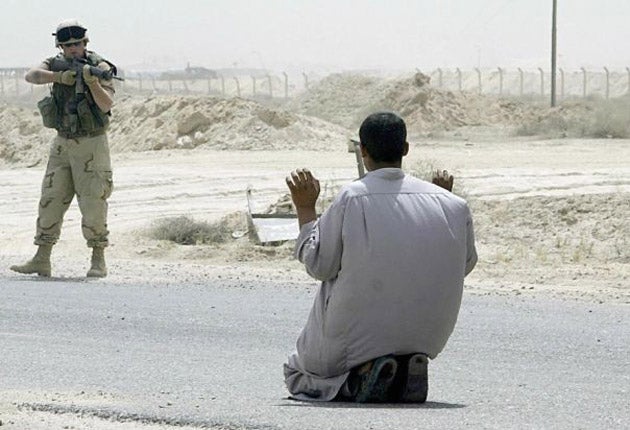Huge dossier of secret files shows the US ignored torture of Iraqis
Estimate of civilian deaths rises to 122,000 / Killings at checkpoints were 'covered up' / Pentagon furious over biggest ever leak

Whistle-blowing website Wikileaks unveiled its cache of secret Iraq war documents last night in what is the largest leak in US military history.
The reports deliver a devastating verdict on the Coalition's involvement in Iraq including revelations that the American military:
*Knew Iraqi officials were torturing detainees but ruled against intervening.
*Conspired to cover up the deaths of "hundreds" of Iraqi civilians at manned checkpoints.
*Kept records of the number of Iraqi civilians that were being killed, despite famously claiming that the military "didn't do body counts".
The documents also reveal how Iran has provided direct military aid and training to Shia militias behind much of the sectarian bloodletting and attacks on Coalition forces in Baghdad and southern Iraq.
Nearly 400,000 secret documents, an enormous trove of field reports covering more than five years of military involvement in Iraq, have gone online to the consternation of US officials who claim the publication will endanger both soldiers and informants on the ground in Iraq.
The reports show that, despite repeated denials, the US government does indeed have a detailed – though incomplete – list of civilians killed in Iraq with the logs recording 66,081 non-combatant deaths out of a total of 109,000 fatalities.
According to Iraq Body Count, the London-based organisation which began counting Iraqi civilian casualties after the invasion and has been given access to the Wikileaks cache, the logs reveal at least a further 15,000 extra civilian deaths that were previously unknown. They now intend to revise their total estimate for the number of Iraqi civilians killed from 107,000 to at least 122,000. They say that the US military's troops tend to underestimate the number of civilians killed. For instance, in the more than 3,800 airstrikes logged in the Iraq war reports, according to US military figures, just 103 fatalities were civilian.
The secret files, which cover a period from January 2004 to December 2009 and are largely made up of reports from units in the field and military intelligence, reveal that torture has remained widespread within the Iraqi police and army, despite repeated assertions from both the Bush and Obama administrations that they would not tolerate such abuses in an Iraq post-Saddam Hussein.
Over the five years covered by the logs, American troops encountered at least 1,300 instances of Iraqi-on-Iraqi torture, including regular reports of detainees being electrocuted, sodomised with objects and beaten to death. At least six prisoners are reported to have died in custody and there are a number of examples of torture continuing up until very recently.
In August 2009, for instance, an Iraqi detainee committed suicide in prison. The American log of the incident found "found bruises and burns on the detainee's body as well as visible injuries to the head, arm, torso, legs, and neck."
Four months later 12 Iraqi soldiers, including an intelligence officer, were caught on video in Tal Afar shooting to death a prisoner whose hands were tied. It is unclear whether any follow up was made by the US authorities to either instances but Amnesty International claims no Iraqi personnel have been jailed for torture since the invasion. Sexual abuse also appears to be commonly employed against women in Iraqi custody.
Such instances will be a major source of embarrassment to the Obama Administration which campaigned during on ending some of the more notorious human rights abuses committed under his predecessor George W Bush.
The documents also reveal how two secret orders handed down to troops in 2004 and 2005 told soldiers that they should only report instances of abuse by Iraqi officials to their commanders and should not intervene directly. The archive also contains reports on at least four cases of lethal shootings from helicopters and 700 instances if civilians being killed at manned checkpoints.
In February 2007 an Apache helicopter killed two insurgents from a mortar team who were trying to surrender to them after a military lawyer decided that enemies "cannot surrender to aircraft". The same helicopter, which used the call sign Crazyhorse 18, was the subject of a previous leak earlier this year which showed how the two man aircraft killed a group of insurgents, civilians and two reporters from the Reuters news agency.
The field reports, which were never meant to be made public, also shine a spotlight in Iran's involvement in Iraq. US troops were repeatedly warning their commanders that Iran's Revolutionary Guards and Lebanon's Hizbollah were providing Iraqi Shia militias with training, sanctuary and hardware – including rockets, magnetic bombs that can be attached to the underside of cars, and "explosively formed penetrators," a complex type of explosive device that can punch through armour.
Speaking on Al Jazeera last night Wikileaks' founder Julian Assange described the publication of the documents as an "historic" moment. "This is six years of history, the most extraordinary compendium of war that has ever been released during a time of war," he said.
But the release has been severely criticised by the US government.
"This security breach could very well get our troops and those they are fighting with killed," a Pentagon spokesman said yesterday. "Our enemies will mine this information looking for insights into how we operate, cultivate sources and react in combat situations, even the capability of our equipment."
Join our commenting forum
Join thought-provoking conversations, follow other Independent readers and see their replies
Comments